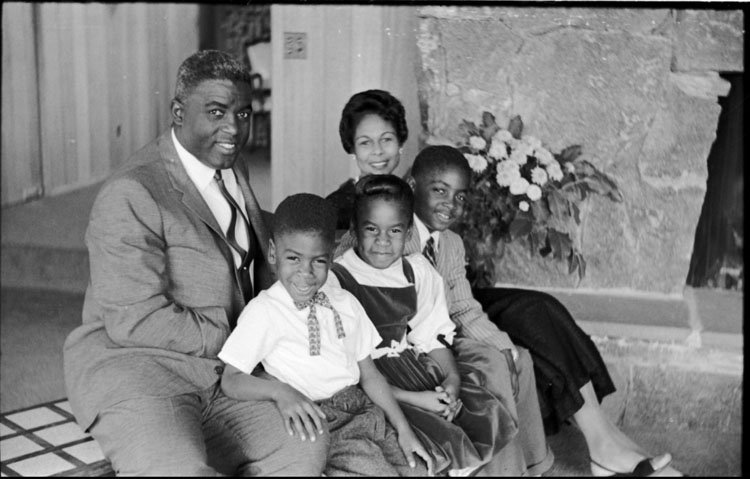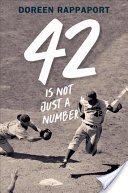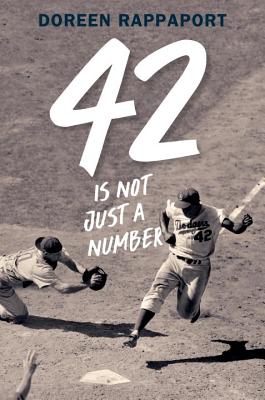Reviewed by Don Allen
Review Source: Teaching for Change
Book Author: Doreen Rappaport
For many kids, sports can be a window into the injustices that have desecrated the American democratic experiment, since its beginnings.
I was one of those kids. I loved sports and I lived in a town and attended a school that lacked diversity. I can still vividly remember where the sports books were kept in my elementary school library. In those books, mainly biographies, I learned about (and felt intensely) the Jim Crow experiences of the Negro Baseball Leagues via Hank Aaron, Satchel Paige, and Roy Campanella. Without sports biographies, my education would have had giant gaps (more than it did). Rappaport’s biography of Jackie Robinson can be the same sort of window for kids who are not receiving the full picture of U.S. history.
Rappaport does a masterful job of painting Robinson’s early life and the obstacles faced by him and all African Americans. Robinson grew up in a California, a part of the country that is not associated with the strict segregationalist policies of the south. However, Rappaport reminds us that it was still Jim Crow, but without the “Whites Only” signs. She also paints a fuller picture of Robinson himself.

In the popular myths, Branch Rickey chose Robinson to integrate major league baseball because he had the temperament to take the projected abuse and slurs of the white populace. In truth, Robinson had a fiery temper and had refused to accept segregation and racism for much of his life. Robinson’s strength of will to take the onslaught of abuse demonstrates his remarkable courage and the strength of his intelligence, understanding what he needed to do to make his integration into MLB work. In the popular narrative of Robinson, Rickey is given much of the credit for breaking the color line. While it is true, it took one rich, powerful owner to make it happen, almost all of the difficulties were suffered by Robinson and his family. Rickey did challenge the unfairness of the segregated system, but underneath it all, he was a businessman first.

African Americans attendance at MLB games increased tremendously with the addition of Robinson – and Rappaport makes sure that it is part of the Robinson narrative. She doesn’t mention that Rickey did not compensate Robinson’s team in the Negro Leagues, the Kansas City Monarchs. The poaching of Black players by MLB eventually led to the collapse of the Negro Leagues, which at one time were great examples of Black-owned businesses during a time when such examples were not plentiful. To contrast to today’s MLB, the team of Japanese star, Shohei Ohtani, was compensated $20 million when he signed a contract in the U.S.
While I recommend this book highly for grades 3 to 5, I want to point out a couple of minor shortcomings. Although she is baseball lover, Rappaport’s strengths involve writing about social conditions, and not sports. Her descriptions of actual games are not as thrilling as the descriptions of Robinson’s battles with racism. Maybe those are the priorities we should have as a society, but it won’t be as effective in engaging sports-loving kids. Also, in the Author’s Note, she describes Robinson as a “one person civil rights movement.” She intends this to be a compliment to Robinson, but it is ahistorical and ignores the crucial role of the thousands of people who made civil rights a movement. This anecdote can explain. In 1944, Robinson refused to go to the back of a bus on a military base. He was arrested. 1n 1955, Rosa Parks refused to go the back of bus, four days later the Montgomery bus boycott was launched. Thousands of people joined the well-organized boycott and, after a year, the Civil Rights Movement had a seminal victory. While Robinson’s refusal to move on the bus was courageous, it is not the same as or as effective as what the people in Montgomery did.
April 15 is Jackie Robinson day in major league baseball. I hope that curious young readers find Rappaport’s book to help them understand why we celebrate on that day by wearing number 42.


42 Is Not Just a Number by Doreen Rappaport
Published by Candlewick Press on September 5th 2017
Genres: African American, Biography and Autobiography, People & Places, Sports
Pages: 128
Reading Level: Grades 3-5, Grades 6-8
ISBN: 9780763676247
Review Source: Teaching for Change
Also by this author: Martin's Big Words
An eye-opening look at the life and legacy of Jackie Robinson, the man who broke the color barrier in Major League Baseball and became an American hero.
Baseball, basketball, football -- no matter the game, Jackie Robinson excelled. His talents would have easily landed another man a career in pro sports, but such opportunities were closed to athletes like Jackie for one reason: his skin was the wrong color. Settling for playing baseball in the Negro Leagues, Jackie chafed at the inability to prove himself where it mattered most: the major leagues. Then in 1946, Branch Rickey, manager of the Brooklyn Dodgers, recruited Jackie Robinson. Jackie faced cruel and sometimes violent hatred and discrimination, but he proved himself again and again, exhibiting courage, determination, restraint, and a phenomenal ability to play the game. In this compelling biography, award-winning author Doreen Rappaport chronicles the extraordinary life of Jackie Robinson and how his achievements won over -- and changed -- a segregated nation.

Leave a Reply